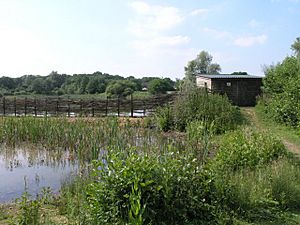Sevenoaks Gravel Pits facts for kids
| Site of Special Scientific Interest | |
 |
|
| Area of Search | Kent |
|---|---|
| Interest | Biological |
| Area | 73.7 hectares (182 acres) |
| Notification | 1989 |
| Location map | Magic Map |
Sevenoaks Gravel Pits is a special nature spot covering about 73.7 hectares (that's like 182 football fields!). It's located just outside Sevenoaks in Kent, England. This area is known as a Site of Special Scientific Interest (SSSI) because of its amazing wildlife. The Kent Wildlife Trust looks after it, and it's also home to the Jeffery Harrison Visitor Centre.
How This Amazing Place Was Made
This special nature reserve used to be a place where people dug up gravel and sand. But thanks to the Harrison family, especially Jeffery Harrison, it was turned into the beautiful wildlife haven we see today. The visitor centre is even named after him!
What's really cool is that almost everything here was made by people. The lakes and ponds were created by digging out the old gravel pits and filling them with water from the nearby River Darent. Most of the trees you see were also planted by hand. This was the very first time a gravel pit in the United Kingdom was turned into a nature reserve like this!
Over time, the gravel and sand areas became woodlands. These woods are now home to many different birds, like woodpeckers, warblers, and tits. You can also spot birds that visit in winter, like siskins, who come to eat seeds from alder trees.
Some parts of the reserve are left to grow old naturally. This creates lots of dead wood, which is perfect for fungi and insects. Other areas have trees that are "coppiced." This means they are cut back to encourage new growth, creating different types of habitats. The reserve also has five lakes, plus many ponds, pools that fill up with water when it rains, and reedbeds. All these different areas, from wetlands to woodlands, help support a huge variety of plants, fungi, and animals. In fact, over two thousand different species have been found here!
Why Sevenoaks Gravel Pits is Special
Sevenoaks Gravel Pits is officially recognized as a Site of Special Scientific Interest (SSSI) because of its amazing bird populations. It's a fantastic place for birds to breed and spend the winter.
The way the lakes are designed, with shallow areas, spits of land, and islands, along with all the trees and water plants, makes it perfect for birds. The water levels in the lakes are carefully managed. This means that during spring and summer, islands and shallow spots appear. These areas are great for wading birds and waterfowl to find food and build their nests. You might see birds like the little ringed plover, lapwing, moorhen, coot, and great crested grebe.
In the colder winter months, lots of wildfowl come to use the open water. These include birds like the tufted duck, greylag geese, and Canada geese.
The most common birds that breed here are Canada geese, greylag geese, mallards, and tufted ducks. But in winter, and during their migration, other wildfowl also visit, such as the pochard, shelduck, teal, and shoveller. You can also find wading birds like the greenshank and green sandpiper, and the special little ringed plover, which regularly breeds here.
If you explore the woodlands and reed beds, you might hear songbirds like the whitethroat, reed warbler, and sedge warbler. There's also a large group of sand martins living in a sandy cliff towards the south of the site. These birds have seen their numbers change a lot in recent years, so it's great to have them here.
The SSSI status also highlights the growing number of interesting plants (botany) and insects (entomology) at the site. You can find thirteen different types of Odonata (that's the group that includes dragonflies!), including the beautiful downy-emerald dragonfly (Cordulia aenea). Some special plants here are small cud-weed (Filago minima), dwarf elder (Sambucus ebulus), and slender bird's-foot trefoil (Lotus angustissimus).

